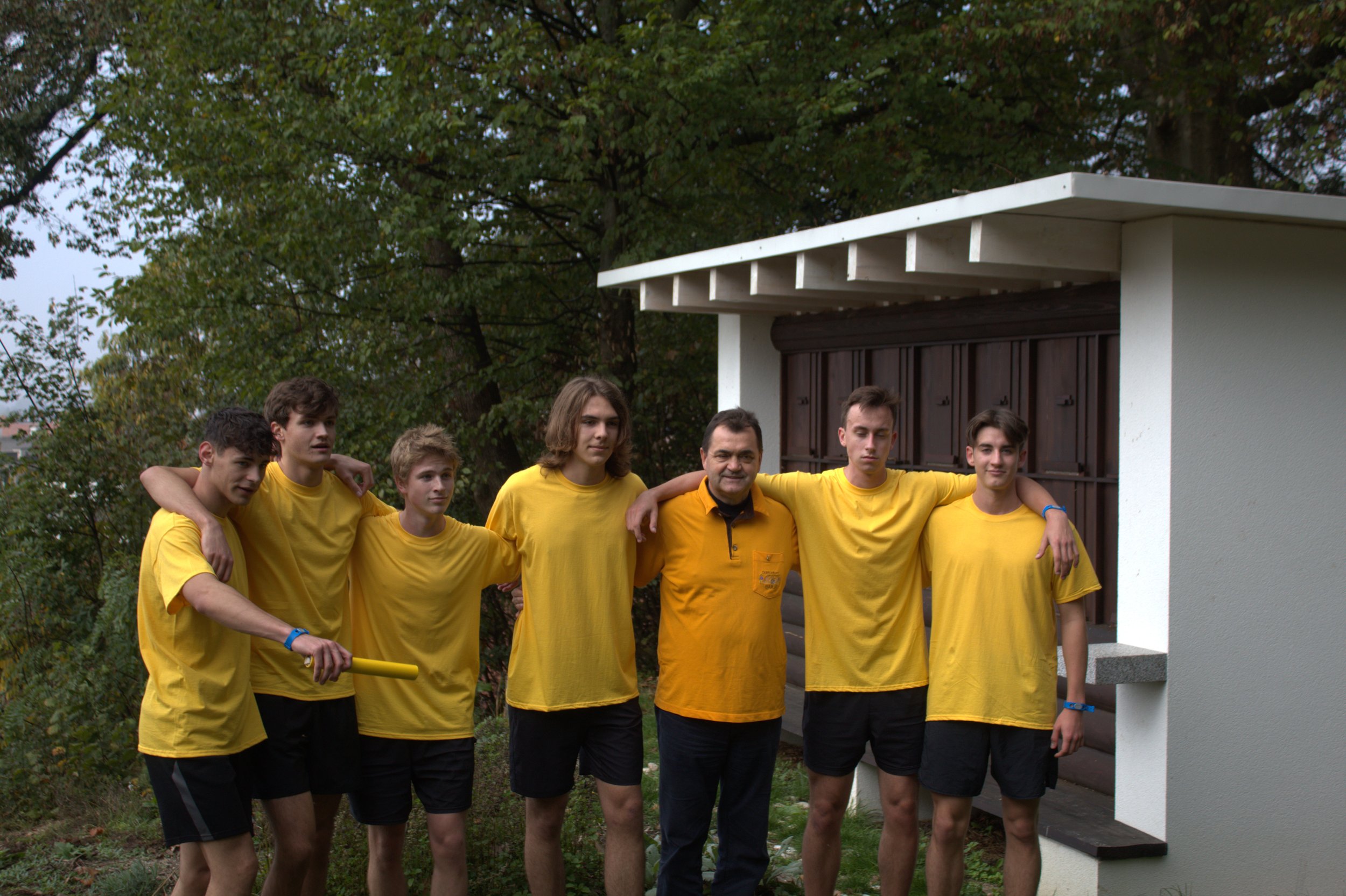Text by Lucija Rotar, Young Reporter for the Environment, Slovenia
Photos and poster by Žiga Vaupotič, Young Repoter for the Environment, Slovenia
The high school of Jože Plečnik Ljubljana, located in the very center in the capitol of Slovenia, joined the longest continuous climate initiative Running out of Time. We decided to participate in the Climate Run that follows the so-called ‘Bee path’ in the Municipality of Ljubljana. Trail we have chosen consists of five stops, each with its own beehive.
On the October 19th 2022 we joined the longest continuous climate initiative Running out of Time, which connects several European countries towards a common goal. In addition to the runners and students from the High school of Jože Plečnik, many teachers and experts have participated in the Running out of Time project, along with pupils from the Livada Elementary School and our beekeeper mentors, who contributed to the initiative with enthusiasm and joy.
Our green initiatives
We have been creating green initiatives at our school for many years now. Together we have created our school's urban roof garden seven years ago. Soon we have arranged the upper school terrace for a green shelter too. Last year, our school set up the first beehive on the terrace in order to contribute to the preservation of bees and to help increase biodiversity in the city by that. Bees teach us persistence, cooperation, exploration and coexistence. Our beekeeping slogan is "Learning with and from bees".
Running on the Bee Path
This is precisely why our team decided to participate in the Climate Run that follows the so - called ‘Bee path’ in the Municipality of Ljubljana. Trail we have chosen consists of five stops, each with its own beehive. The first was on the terrace of our high school, next one at the replica of Plečnik’s beehive on Castle hill, third stop was at the Botanical Garden, next one to the beehive at the Livada Elementary School and the last one to the beehive in the garden of architect Jože Plečnik's house. Our students of differing classes visited these locations and gained some environmental based information about each stop.
Why bees?
"The bee is an indicator to the cleanliness of an environment, as it is one of the first to feel the changes in it, so bees should be seen as "environmentalists"... We should observe bees and follow in their lead, they will guide us in the direction of a clean and healthy environment, an environment that is perfect for both bees and humans." (Boštjan Noč, President of the Beekeeping Association of Slovenia).
A group of 3rd grade high schoolers wore yellow shirts to the Climate Run event as a part of International Running out of Time. Yellow colour symbolizes bees. They ran along a trail that encompasses the fly path our bees can take from their terrace beehive. In this way, we want to symbolically commit to their way of living. Doing so we would be able to understand the interrelation of a living being and nature, using bees as an example of a strong bond between the environment and a species. In this way we could become more responsible towards the nature surrounding us.
How we ran
We started our Climate Run with a short ceremony on the school terrace in the presence of the assistant principal and students. After a musical performance done by our two students and their mentor, the student council president presented the environmental initiative Running out of Time. The project is primarily intended to raise awareness among young people about climate change and to encourage them to make a significant contribution to the environment through their actions.
Runners Jaka, Gašper, Marcel, Maks, David and Balazs of the High school Jože Plečnik Ljubljana on the school rooftop, where the school beehive is located - the starting point of their Climate Run on the bee path.
Students ran through the city center – this is also where the RooT Climate Baton passed Ljubljana during the night.
Towards the Ljubljana Castle hill.
After the council president’s speech surrounding the Climate Run, we also presented the message of our school. Afterwards, our runners Jaka, Gašper, Marcel, Maks, David and Balazs, carried the climate Running Out of Time Baton along the Bee trail in the Municipality of Ljubljana. They ran from the school, through the streets of the old city centre and towards the replica of Plečnik's apiary on the Castle hill, where the high school students of 3.D were already awaiting them. After the Climate message was read, the runners continued their journey towards their next point, while the other students and their mentor listened to the lecturer Aleš Süssinger from the Barje Bee Association, who shed light on the importance of beekeeping and our renowned architect Jože Plečnik. Last year, Mr. Aleš led the beekeeping club at our high school, where students learned about the beekeeping profession, bees, and the importance of both on our environment.
The architect Jože Plečnik, who designed this apiary, also holds great significance, not only for our high school, after whom it is named, but also for Ljubljana and Slovenia as a whole. By designing the beehives, he substantially elevated this part of our Slovenian cultural identity and beautifully connected both art and our national cultural heritage.
In front of the replica of Plečnik's apiary on the Castle hill.
The runners continued along the Bee path towards the Botanical garden. There they were awaited by the high school students of class 3.A and their mentor. Before the arrival of the runners, an expert of botany introduced them to the role of plant pollinators and their influence on the stability of ecosystems. Established in 1810, the Ljubljana Botanical Garden is Slovenia's oldest cultural, scientific and educational institution operating uninterruptedly since its foundation. The route then led the runners to the apiary at Livada Elementary School.
Runners and classmates in front of the beehive in the Botanical Garden.
A welcome by the 3rd grade students and their teacher. At the apiary, two beekeepers talked to the youth about the role of bees and their goods. They also prepared medenjaki (honey biscuits) and honey lemonade for everyone to enjoy.
The runners also stopped at Plečnik's house in Trnovo, where they saw the beehive in the architect's garden. From there, they continued running all the way to the finish line. Participating runners showed perseverance and collective spirit from the start and all the way to the finish line on this 11 km route. The safety of the running team was ensured by two teachers of sport who accompanied them on bicycles.
A beehive in front of the famous Slovene architect Jože Plečnik house.
I can contribute too
I am happy that I contributed to the project myself, as I created the logo that was printed on the runners' T-shirts. Since our school is known for our bees, also called ‘šubelce’ (a portmanteau of the word ‘čebelice’, meaning bees and the word ‘šuba’, a shortened version of our high school's name), I decided to depict bees, surrounding a hive on the logo. The beehive has a very simple shape, which is why it is easily recognisable, so I thought it would be appropriate as the background of the logo. The bees are also supposed to symbolize us, the students, who work hard and achieve a desired goal through our combined efforts. I also found this symbol appropriate for the Running out of Time project.
I always try to participate in projects that inspire young people with nature and teach them how to preserve our Earth, as it is something that I am deeply interested in it. The same applies to the entire class of 3.A, of which I am a part of it. We are trying to understand the causes of climate change and find ways with which each of us could contribute at least a little to reducing these problems. Since we are a science-focused class, there is an emphasis on subjects like biology, physics and chemistry from which we are able to better understand the world we live in. This is also a reason why we often help with various ecological projects that need young people to develop new ideas in which could help build a greener future.
We are aware that we represent the next generation that will have to face these problems head-on. We will contribute to solving and inventing better technologies that would be able to change the situation on our planet for the better.
We, young people, are worried about the future and find it difficult to bear such a large burden of saving our environment. As teenagers, we often face feelings of hopelessness and think that we cannot change much on our planet, even so, we must try and keep ourselves grounded and logical as well as realize that even the smallest step of achievements help to improve the state of our Earth.
At the same time, we must not be blinded by false optimism, we must remain realistic but maintain hope, as overwhelming pessimism hinders our ability to fix these problems.
Humans have an innate quality that makes us more inclined to react to bad news, it is also easier for us to remember past negative events and experiences. That is why news and mass media today in general catastrophizes problems that make us feel dejected and hopeless. The same also occurs with climate change, because its consequences are incredibly severe, we feel like there is no end to the struggle with problems of for example deforestation, water shortages, increased temperatures, unpredictable weather ... the consequences of global warming just don't stop.
But we must have hope and believe that we can change things for the better. Education plays an important role and we want every child to have an opportunity to better understand our planet. Educated people know the severity of the problems from global warming and this is already the first step towards change in our proper environmental acting. As a global community we must fight against these problems, or else the consequences are going to become even more grave.
However, we must be aware that as individuals we cannot do much, which is why projects like Running out of Time are so important. If more of us stand up to these problems, we cannot be easily silenced. That is why I believe that working together is our greatest tool for amplifying our voices. One voice is weak, but we can hear a crowd with ease.
The route of the Climate Run of the High school Jože Plečnik Ljubljana – Bee path.
Poster of the Climate Run of the High school Jože Plečnik Ljubljana.
Lucija and Žiga
Lucija and Žiga are both students and Young Reporters for the Environment at the High School of Jože Plečnik, in Ljubljana, Slovenia. The High School of Jože Plečnik is an Eco-School that organized this additional 'Bee Path' as part of the Running Out of Time relay that closely connected the beehives and noteworthy attractions of the famous Slovene architect Jože Plečnik (whom the school is namer after. A primary school, beekeepers and classmates also participated. Lucija and another student Nik Koprivec will be attending a UNESCO Youth Session titled “Youth Demand Quality Climate Education: Outcome of Global Survey” on the 15th of November at COP 27. Register for this event here.
Young Reporters for the Environment (YRE) is a programme developed by the Foundation for Environmental Education. In Slovenia, the YRE programme is coordinated by our member, Društvo Doves (FEE Slovenia).





















